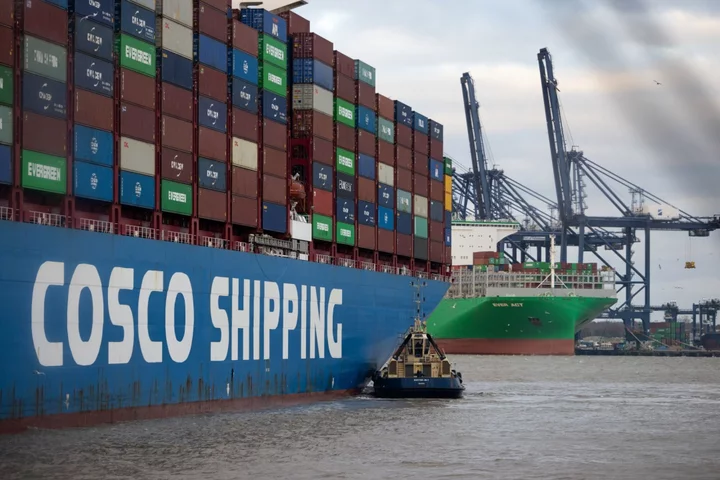Supply Lines is a daily newsletter that tracks global trade. Sign up here.
As economists gauge the likelihood of recessions in major economies around the world, a slew of recent data show that a downturn is already evident when it comes to global commerce.
China, the world’s biggest exporter, this week reported the biggest contraction in overseas shipments since Covid-19 walloped the nation in February 2020. Germany, the global No. 3, saw its exports sink in the latest monthly data by the most on a year-on-year basis since early 2021.
Exports from the US, which pips Germany for the global No. 2 slot, also contracted over the year to June. But the American economy is enjoying a newfound sense of optimism thanks to an ingredient many of its rivals lack: robust domestic demand.
It’s not alone. A number of countries with resilient internal dynamics are standing out. Indonesia, the biggest Southeast Asian economy, saw growth accelerate last quarter despite a nosedive in exports that was triggered by a sharp decline in prices for the nation’s commodities, like crude palm oil, coal and iron. India’s expansion is projected to have strengthened last quarter amid a pickup in investment.
For providers of services in nations enjoying solid job and income growth, hard-landing fears appear overdone. But until the global manufacturing cycle works off a build-up of inventories, export-oriented economies will pose a drag on world growth.
“Both sectoral and regional divergences have opened” in the global economy in recent months, JPMorgan Chase & Co. economists Joseph Lupton and Bruce Kasman wrote in a note to clients this week. “The higher gearing of Europe and China” to the industrial cycle has been one stand-out feature, they said.
China’s export downturn has left it particularly exposed, with consumer confidence at depressed levels and a property-market slump hampering a rebound from last year’s pandemic lockdowns.
Germany’s export weakness has seen its industrial production languish at a six-month low, making its emergence from a recession earlier this year all the tougher.
Goods Cycle
The risk is that European and Chinese weakness “could spread to the US and the rest of the world,” Lupton and Kasman wrote. In time, the duo anticipates a “turn back up in the goods-production cycle.”
But for now, there’s a welter of ugly data.
- India’s merchandise exports plunged 22% in June from a year earlier.
- Taiwan’s exports tumbled for 11 straight months.
- Vietnam is mired in the longest slump for shipments abroad in 14 years.
- Canada’s merchandise-trade balance recorded its second consecutive monthly deficit in June on falling exports.
What’s also evident in the latest figures is some reshaping in global trade flows, amid a push by Western nations led by US President Joe Biden to reduce reliance on China and Russia.
Mexico has recaptured its top spot as the No. 1 exporter to the US, pushing China to third, after Canada. And China’s data show shipments to the US plummeted 23.1% in July. Exports to markets including Japan, South Korea, Taiwan, the European Union and Australia all dropped by double-digit percentages. But its shipments to Russia surged 73% this year.
Read More: Bidenomics Is Bringing ‘Supply Chains Back Home,’ Biden Says
China’s share of Germany’s total exports dropped to 6% in the first half of this year from 8% in 2020, according to the Kiel Trade Indicator gauge.
More broadly, Europeans are expressing concern about an increasingly unbalanced pattern of trade flows with China, as Chinese shipments of electric vehicles to the continent soar. Beijing has hit back that the gap is the fault of the EU’s own export controls.
Read More: China Says Europe’s Soaring Trade Deficit Is Its Own Fault
One of the world’s largest shippers, A.P. Moller-Maersk A/S, said last week that global container trade will probably contract as much as 4% this year — even worse than a previous prediction of a 2.5% contraction.
“There’s a lot of moving parts right now, from rate hikes and the risk of recession,” as well as “uncertainty also about GDP growth in China and what demand is going to be in China next year,” Maersk CEO Vincent Clerc said on Bloomberg Television on Aug. 4.
Maitreyi Das, an economist at HSBC Holdings Plc, one of the world’s leading banks for trade financing, said that “higher interest rates and resilient inflation has impacted real income, especially in developed markets,” diminishing demand for goods.
Negative Baseline
For its part, the team at Oxford Economics this week cautioned that growth in the world economy “looks likely to be weak in the next few quarters.” The group’s “baseline forecast still looks for growth in the advanced economies to slip into negative territory at the end of 2023 or early 2024.”
Still, there are some signs of hope. Data from Taiwan, a crucial part of global supply chains thanks to its semiconductor business, show the decline in chip exports is slowing.
If indeed the global cycle in goods turns, economic models suggest that a shift in China would go on to serve as “a harbinger for broader strength elsewhere,” JPMorgan’s Lupton and Kasman wrote.
(Updates with Europe-China flap over trade balance, in third paragraph after second chart.)

